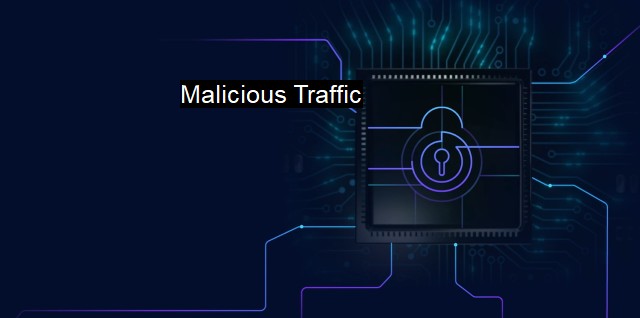What is Malicious Traffic?
Facing the Threat of Malicious Traffic: Understanding the Growing Cybersecurity Risk and How to Mitigate It through Examining the Key Drivers of Malware, Botnets, Vulnerability Scans, and Port Scanning
Malicious traffic refers to data patterns sent over the internet or intranet which raise red flags for security systems. Such traffic is an indication of potential threats such as virus infections, hacking attempts, or other types of cyber attacks.Malicious traffic can be deemed as any transaction within a network that was specifically designed with ill intentions or to inflict harm to persons or institutions. These destructive patterns often make use of exploitation by infecting machines and communicating with external servers for both financial gain and control leverage.
Cybersecurity systems are designed to identify and thwart this type of traffic to prevent significant harm to users and systems. They do this by registering signatures and detecting anomalous behaviors that suggest harm. these systems need to be constantly updated and upgraded to adapt to the changing nature of malicious traffic methods and patterns.
In terms of harmful data, the types of malicious traffic vary on a considerable scale. They range from worms and viruses that can infect individual computers or entire networks, distributed denial of service (DDoS) attacks where networks are purposely overwhelmed to crash them, malicious bots, and botnets that can seize control of systems for nefarious purposes, and ransomware infections that encrypt data and demand a ransom for its release.
Identifying malicious traffic can often be more challenging than expected. It often takes the form of legit network traffic to bypass gainsafe systems. Leveraging encryption for masking ill-intended activities is a common technique used by attackers. Another technique is the leverage of innocent situations to deliver payloads effectively. For instance, a seemingly harmless email may coax an unsuspecting user into opening a macro-enabled file that then initiates and executes a malware.
Antivirus software plays a significant role in preventing, detecting, and eliminating the threats arising from malicious traffic. This software deploys the use of signature and heuristic based detection methods to root out known and unknown threats. Essential to this is the continuous updating of antivirus software, which ensures it is familiar with the latest attacks and can provide the best protection possible.
In terms of signature-based detection, antivirus software filters incoming data packets for known threat signatures while heuristic detection relies on behavioral analysis targeting system activities that do not sit well within established norms. This offers a two-pronged screening process to identify potential threats that possibly come with malicious traffic.
Alongside antivirus software, other cyber defense mechanisms, like deep packet inspection, firewalls, intrusion detection, and prevention systems, help to detect and categorize malicious traffic. Securing an own traffic is also crucial. For both small and big organisations securing their traffic is vital. With secure traffic, organisations can better protect their critical infrastructure, sensitive data, and operations from the potential effects of malicious traffic.
Among the practical steps to protect against malicious traffic are Virus scanners and updates, software updates, and patches diligently always kept up to date, swift detection of and response to security breaches, and secure management of digital certificates and cryptographic keys. Sound staff training and solid command of cyber hygiene can also help to significantly reduce the risk of falling prey to threats driven by malicious traffic.
Malicious traffic poses a constant and evolving threat in the realm of cybersecurity. It represents the transmission of harmful data over a network. The robust measures in place, like antivirus software and other tools, which are continually refined to deal with malicious traffic ways and patterns effectively. Although eradication of these threats might seem difficult as they evolve continuously, their mitigation and control is viable with vigilant defense systems in place, accompanied by proactive measures like upgrades of antivirus databases, staff training, and the propagation of cyber hygiene.

Malicious Traffic FAQs
What is malicious traffic in cybersecurity?
Malicious traffic in cybersecurity refers to any network traffic or information that is deliberately designed to disrupt, damage, or gain unauthorized access to a system or network. It can come in many forms, including viruses, worms, trojans, denial of service (DoS) attacks, and botnets.What are the common sources of malicious traffic?
The common sources of malicious traffic include phishing emails, infected or compromised websites, unsecured networks, mobile apps, and social engineering techniques.What are the potential dangers of malicious traffic to an organization?
Malicious traffic poses a wide range of potential dangers to an organization, including data theft, system and network damage, reputation damage, financial losses, and legal liabilities. It can also lead to business disruptions, operational downtime, and decreased productivity.How can an organization protect itself from malicious traffic?
An organization can protect itself from malicious traffic by implementing a robust cybersecurity and antivirus solution, educating employees on safe browsing and email practices, regularly updating software and security patches, implementing firewalls and intrusion detection systems, and regularly backing up data. It is also important to monitor network traffic and have incident response plans in place to quickly detect and respond to any potential threats.| | A | | | B | | | C | | | D | | | E | | | F | | | G | | | H | | | I | | | J | | | K | | | L | | | M | |
| | N | | | O | | | P | | | Q | | | R | | | S | | | T | | | U | | | V | | | W | | | X | | | Y | | | Z | |
| | 1 | | | 2 | | | 3 | | | 4 | | | 7 | | | 8 | | |||||||